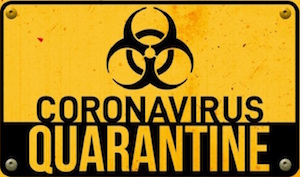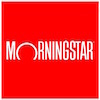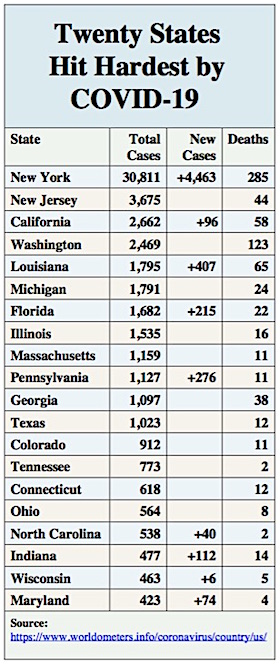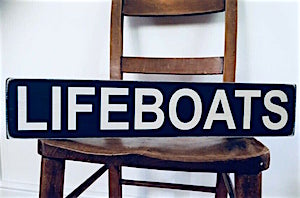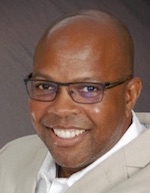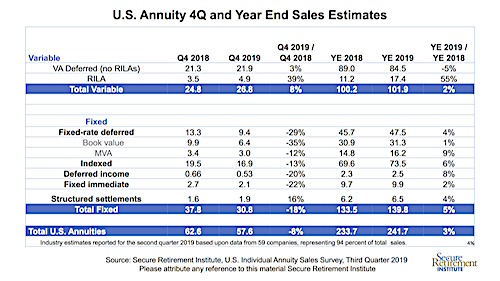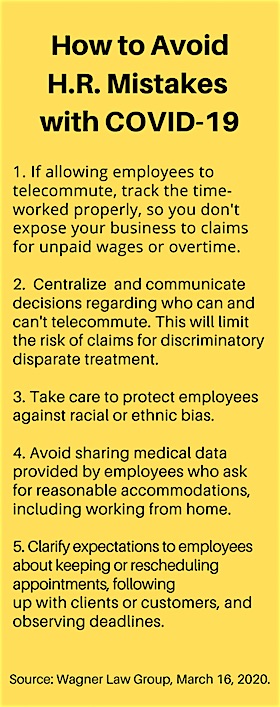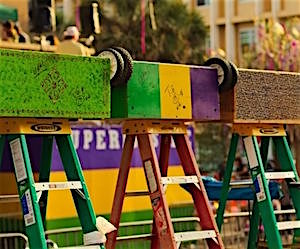
The Families First Coronavirus Response Act
(Updated to Include Coronavirus Aid, Relief, and Economic Security Act Provisions) April 1, 2020
This Law Alert serves as an update to the Law Alert sent out on March 19, 2020 concerning the paid leave and group health plan provisions of The Families First Coronavirus Response Act. Effective April 1, 2020, the Emergency Paid Sick Leave Act (the “Sick Leave Act”) and the Emergency Family and Medical Leave Expansion Act (the “FMLA Expansion Act”), two of the divisions of the Families First Coronavirus Response Act (the “Families First Act”), as amended by the Coronavirus Aid, Relief, and Economic Security Act (the “CARES Act”), provide paid sick leave and paid family and medical leave to employees affected by the coronavirus. They also provide tax credits for eligible employers. These provisions expire on December 31, 2020.
The Families First Act also requires, effective as of March 18, 2020, and continuing for the duration of the federal declared emergency (the “Emergency”), that group health plans and health insurance issuers offering group insurance coverage, including grandfathered health plans under the Affordable Care Act, provide coverage of testing and diagnosis for COVID-19 without any cost-sharing requirements. Also, until 2021, the CARES Act permits pre-deductible coverage of telehealth and other remote care. The CARES Act also requires, permanently, that group health plans and health insurance issuers (including grandfathered plans) cover COVID-19 vaccines (once there are any such vaccines), and permanently permits over-the-counter drugs to be reimbursed by HSAs, FSAs, HRAs, and Archer MSAs, whether or not they were prescribed by a physician.
Emergency Paid Sick Leave Act
Employers with fewer than 500 employees and government employers must provide employees with paid sick leave. While the Sick Leave Act does not address the issue, the DOL has indicated that all employees of the employer are taken into account – full-time, part-time, temporary, seasonal, and union. Each separate employer entity is a separate employer for purposes of the 500-employee threshold, except that two or more employer entities may qualify as the “joint employer” of a group of employees, or all the entities in a controlled group may qualify as an “integrated employer” if the parent has de facto control over the operations of all. Employees may take paid sick leave if the employee:
- is subject to a federal, state or local quarantine or isolation order;
- has been advised by a healthcare provider to self-quarantine;
- is experiencing symptoms of COVID-19 and is seeking a medical diagnosis;
- is caring for an individual who is subject to a federal, state, or local quarantine or isolation order, or has been advised to self-quarantine by a healthcare provider;
- is caring for a son or daughter whose school or day care has been closed or the regular child care provider is not available due to coronavirus; or
- is experiencing any other substantially similar condition specified by the Secretary of Health and Human Services.
A big exception: healthcare providers and emergency responders are not required to provide paid sick leave to employees.
At present, employees, who are laid off before the paid sick leave requirements go into effect, will not be eligible for paid sick leave. Employees placed on furlough on or after April 1,2020, are also ineligible. If an employer closes a worksite on or after April 1, 2020, paid leave will also be unavailable.
The Department of Labor (the “DOL”) has the authority to exempt small businesses with fewer than 50 employees if the imposition of the paid sick leave requirements would jeopardize the viability of the business as a going concern.
Paid sick leave must be available to all employees of employers subject to the Sick Leave Act (those with fewer than 500 employees), regardless of their date of hire. An employer may not require, as a condition of providing sick leave, that an employee search for and find a replacement employee to cover the hours during which the employee is using the paid sick leave.
Employers who maintain a paid sick leave policy must provide the emergency paid sick leave in addition to their current paid sick leave, and may not require employees to use other forms of paid leave (e.g., vacation leave) instead of the emergency paid sick leave.
Paid sick leave must be paid at the employee’s regular rate of pay if it is used because the employee is being quarantined, has been advised by a health care provider to self-quarantine, or is experiencing symptoms of coronavirus and is seeking a medical diagnosis. Such paid sick leave shall not exceed $511 per day, or $5,110 in the aggregate, for any employee.
Employers must pay two-thirds of the employee’s regular rate of pay if the employee is on leave to care for an individual under quarantine, to care for a son or daughter whose school or day care has closed or the child care provider is unavailable due to coronavirus, or any other circumstance certified by the Secretary of HHS in consultation with the Secretary of the Treasury and the Secretary of Labor. Such paid sick leave shall not exceed $200 per day, or $2,000 in the aggregate, for any employee.
Full-time employees are entitled to 2 weeks (80 hours) of qualified paid sick leave and part-time employees are entitled to the typical number of hours that they work during a typical 2-week period. There is no carryover of this paid sick leave from one year to the next. Paid sick leave ends on the first day of the employee’s next scheduled shift immediately following the termination of the need for paid sick leave. The Sick Leave Act also contains an antiretaliation provision, and further provides that an employer who fails to comply will be treated as having committed a minimum wage violation under the Fair Labor Standards Act.
Employers that contribute to multiemployer plans may fulfill their obligations under the Sick Leave Act (if consistent with the collective bargaining agreement) by making contributions to the multiemployer plan based on the paid leave that each of its employees is entitled to receive under the collective bargaining agreement.
Employees who work under a collective bargaining agreement may secure pay from the fund, plan or program based on the hours they have worked under the collective bargaining agreement.
For employers that are required to provide the paid leave, there is a silver lining. Employers are entitled to a refundable payroll tax credit equal to 100% of qualified paid sick leave wages paid by an employer for each calendar quarter, up to specified caps:
For purposes of the tax credit, the amount of qualified paid sick leave taken into account for each employee who is under quarantine, has been advised to self-quarantine, or is experiencing symptoms and seeking a diagnosis, is capped at $511 per day.
For amounts paid to employees caring for an individual under quarantine, or for a child whose school or day care center has closed or whose child care provider is unavailable due to coronavirus, or who has experienced other circumstances certified by the Secretary of the Treasury, the credit is capped at $200 per day.
The aggregate number of days taken into account for a calendar quarter may not exceed the excess of 10 over the aggregate number of days taken into account for this purpose for all preceding quarters (e.g., if an employee had received pay sick leave for 6 days in the first quarter of the year, then only 4 days would be available in the second quarter).
However, the amount of the credit is increased by so much of the employer’s qualified health plan expenses as are properly allocable to the qualified sick leave wages for which the credit was allowed. Qualified health plan expenses means amounts paid or incurred by an employer to provide and maintain a group health plan, to the extent such amounts are excludible from gross income under the Code. Treasury is directed to issue allocation rules but, unless such rules are to the contrary, an allocation will be treated as proper if made on a pro rata basis among covered employees and pro rata based on the period of coverage.
If the tax credit exceeds the employer’s total liability for payroll taxes for all employees for any calendar quarter, the excess credit is refundable to the employer. For example, if an employer paid $100, 000 in paid sick leave and its payroll tax liability for that quarter was $50,000, it would not make any payroll tax deposit, and would request an expedited refund credit for $50,000. Employers may elect to not have the credit apply. No deduction is allowed for the amount of the tax credit, and no credit is allowed with respect to wages for which a credit is allowed under Internal Revenue Code Section 45S, which provides a tax credit for certain paid family and medical leave.
Self-Employed Individuals
There is a refundable tax credit equal to 100% of a qualified sick leave equivalent amount for eligible self-employed individuals who are under quarantine, are advised to self-quarantine, or have symptoms and are seeking a diagnosis.
For those caring for a quarantined individual, or for a son or daughter whose school or day care has been closed or whose child care provider is unavailable due to coronavirus, or who has experienced other circumstances certified by the Secretary of the Treasury, the refundable tax credit is equal to 67% of the qualified sick leave amount.
The tax credit is allowed against income taxes and is refundable. The credit is capped at $511 per day for the amount paid to self-employed individuals who are under quarantine, are advised to self-quarantine, or have symptoms and are seeking a diagnosis.
For amounts paid to employees caring for a quarantined individual, or a son or daughter whose school or day care center has closed or whose child care provider is unavailable due to coronavirus, the credit is capped at $200 per day.
The aggregate number of days in a period cannot exceed 10, reduced by the number of days previously used.
To calculate the qualified sick leave equivalent amount, an eligible self-employed individual may only take into account those days that the individual is unable to work and is eligible for emergency paid sick leave.
Self-employed individuals must maintain documentation to establish their eligibility for the tax credit.
The qualified sick leave equivalent is reduced to the extent that the qualified sick leave equivalent, plus the qualified sick leave wages from an employer, exceeds $5,110 or $2,000, as applicable (depending on the basis for the sick leave).
Emergency Family and Medical Leave Expansion Act
Employers with fewer than 500 employees, and government employers, must provide each employee who has been employed for at least 30 days with 12 weeks of mostly paid family and medical leave if he or she is unable to work or telework because the employee needs to care for his or her son or daughter, who is under the age of 18, if the child’s school or place of care has been closed, or the child-care provider is unavailable due to a coronavirus declared emergency. That is, it appears that if a parent is at home to take care of a child who is at home because of a coronavirus emergency, and the parent is able to work remotely from home, the parent will not be entitled to the leave. Note that this Act adds an additional basis for taking FMLA leave (loss of child care), but does not increase the length of FMLA leave.
Rehired employees who were laid off no earlier than March 1, 2020, can be eligible immediately if they had at least 30 calendar days of work for the employer, out of the last 60 days, prior to their layoff. In other words, if an employer has had to lay off some employees, the employer can rehire them and put them on paid leave subject to the FMLA Expansion Act without their having to work an additional thirty days.
Employees may take paid family and medical leave after they take the emergency paid sick leave described above. The first 10 days for which an employee takes leave under the FMLA Expansion Act may consist of unpaid leave, but if the employee qualifies for the emergency paid sick leave, the employee may get paid for those 10 days under the Sick Leave Act. An employee may elect to substitute any accrued vacation leave, personal leave, or medical or sick leave for unpaid leave.
Healthcare providers and emergency responders are not required to provide paid family leave to employees. Also, employers with fewer than 50 employees are exempt from the paid family and medical leave requirements if the provision of the paid family and medical leave would jeopardize the business as a going concern. Employers seeking an exemption should carefully document how paid family and medical leave would jeopardize the business. Employers who would not otherwise be employers under the FMLA are excluded from civil enforcement actions by employees.
At present, employees who are laid off before the paid family and medical leave requirements go into effect, will not be eligible for paid family and medical leave. Employees who are furloughed on or after April 1, 2020, are also ineligible for paid family and medical leave. If an employer closes its worksite on or after April 1, 2020, employees will also be ineligible for paid family medical leave.
After the first 10 days of expanded family and medical leave, employees must receive a benefit from their employers equal to two-thirds of the employee’s regular rate of pay times the number of hours the employee would otherwise be normally scheduled to work, with special rules for making this calculation for employees with a variable hourly schedule. Benefits shall not exceed $200 per day, or $10,000 in the aggregate, per employee.
Employers that contribute to multiemployer plans may fulfill their obligations under the Sick Leave Act (if consistent with the collective bargaining agreement) by making contributions to the multiemployer plan based on the paid leave that each of its employees is entitled to receive under the collective bargaining agreement. Employees who work under a collective bargaining agreement may secure pay from the fund, plan, or program based on the hours they have worked under the collective bargaining agreement.
If the credit exceeds the employer’s total liability under the employer’s portion of the social security tax for all employees for any calendar quarter, the excess credit is refundable to the employer. Employers may elect to not have the credit apply. No deduction is allowed for the amount of the tax credit. No tax credit is allowed with respect to wages for which a credit is allowed under Section 45S, which provides a tax credit for certain paid family and medical leave.
Requirements for Group Health Plans
Group health plans and insurers offering health insurance coverage must cover, may not impose any cost-sharing requirements (e.g., deductibles, copayments, and coinsurance) for, and may not impose any prior authorization or other medical management requirements on, the following items and services:
Products used to test for COVID-19 and the administration of such products, if:
- a test has been approved by the FDA;
- the developer of a test has submitted it – or intends to submit it – for FDA approval;
- a test has been developed in and authorized by a state that has notified the Secretary of Health and Human Services (“HHS”) that it intends to review such tests; or
- any other test that the Secretary of HHS determines should be covered, in appropriate guidance;
- Items and services furnished to an individual during visits to a health care (including telehealth), urgent care center, or emergency room that result in COVID-19 testing; and
Any “qualifying coronavirus preventive service,” that is:
- An “evidence-based” item or service, with a rating of A or B in the recommendations of the United States Preventive Services Task Force (the “Task Force”), or
- An immunization recommended for the individual receiving it by the Advisory Committee on Immunization Practices of the Centers for Disease Control and Prevention (the “Committee”).
Payment by the plan or insurer for diagnostic testing must be at payment rates negotiated before the Emergency was declared, if such rates have been negotiated. Otherwise, payment will be at the testing provider’s cash price as listed by the provider on a public Internet Website, or at a negotiated rate that is less than that price. There is a specific requirement for each provider of COVID-19 tests to post its cash price for the test on a public Internet Website, and a provider can be fined up to $300 for each day during the declared emergency that the requirement is violated.
The above testing provisions were effective March 18, 2020, and expire when the Secretary of HHS determines that the Emergency has ended. The requirement to cover a qualifying coronavirus preventive service is effective 15 business days after the date the recommendation is made by the task force or committee in question, and appears to be permanent.
HSAs, FSAs, HRAs, and Archer MSAs
For plan years beginning on or before December 31, 2021, telehealth and other remote care services will be able to be provided by a plan without charging a deductible, and doing so will not disqualify a person eligible for such services from making HSA contributions.
Also, certain over-the-counter items will be allowed to be paid for by HSA, FSA, HRA, and Archer MSA funds whether or not they have been prescribed. In addition, menstrual care products will be considered as medical expenses for purposes of being able to be paid by HSAs. This applies to amounts paid from HSAs and Archer MSAs after December 31, 2019; with respect to FSAs and HRAs, it applies to expenses incurred on or after December 31, 2019.
Conclusion
Paid sick leave and paid family and medical leave is available to eligible employees on April 1, 2020. Any wages required to be paid under the Sick Leave Act and the FMLA Expansion Act will not be considered wages for purposes of the employer’s portion of the social security tax. However, the tax credits described above (other than the tax credits available for self-employed individuals) are increased by the Medicare surtax on qualified sick leave wages and qualified family medical leave wages, subject to the no double benefit rule, as described above, precluding taking a tax deduction for such amount.
At present, there are a number of questions regarding these leaves and the tax credits, which hopefully will be addressed in guidance very soon.
Additional guidance regarding paid sick leave and paid family and medical leave is expected. Guidance already issued from the Department of Labor includes a notice that must be posted in a conspicuous location (e.g., with other labor law posters). Click here for a copy of the notice.
In addition to the leave requirements, employer group health plans will be required to pay for COVID-19 testing and vaccinations. For testing providers that do not have negotiated network arrangements, the plan must pay their cash rate of pay, but that rate of pay must be posted on a public Website. Also, telehealth services can be provided without cost-sharing, and without disqualifying the recipients for HSA contributions, and over-the-counter drugs and medical supplies can be paid by HSAs, FSAs, HRAs, and Archer MSAs.
Withdrawals and Loans from Defined Contribution Retirement Plans
March 30, 2020
In reaction to the current volatility in the economy due to the coronavirus pandemic, we have been receiving a large number of questions from defined contribution plan sponsors regarding ways participants can access money in their accounts. While recognizing such leakage may cause future headaches for participants in their retirement, many individuals do not have the resources to weather this storm and have no other option but to access their retirement accounts.
In-service withdrawals. Many defined contribution plans permit in-service withdrawals. Such withdrawals generally can be provided without restriction from rollover accounts, upon attainment of age 59-1/2 and in the event of a financial hardship. Although salary deferral contributions and safe harbor contributions cannot be distributed unless or until a participant attains age 59-1/2, becomes disabled or terminates employment, plans with profit sharing features can provide in-service withdrawals under other situations. For example, participants may be able to withdraw vested profit sharing amounts if they have been plan participants for at least five years or if the contributions have been in the plan for at least two years.
With respect to hardship withdrawals, not every state has been declared a national emergency for which hardship withdrawals are available under the IRS’s “safe harbor” deemed reasons, and even then an individual has to live and/or work in an affected area for which FEMA will provide individual assistance. In addition, participants could separately satisfy one or more of the deemed hardship situations in the plan – for medical care and expenses, to prevent foreclosure, to pay tuition, etc. Hardship withdrawals are generally subject to ordinary income taxes and a 10% early distribution penalty tax if taken before the participant attains age 59-1/2.
Plan sponsors also may make coronavirus-related distributions available. As noted in our explanation of the CARES Act, coronavirus-related distributions are available at any time during calendar 2020 by an individual (i) who is diagnosed with COVID-19 by a CDC-approved test, (ii) whose spouse or dependent is diagnosed with COVID-19 by a CDC-approved test, (iii) who “experiences adverse financial consequences as a result of being quarantined, being furloughed or laid off, or having work hours reduced due to” COVID-19, (iv) who is unable to work due to COVID-19 child care issues, (v) who has closed or reduced hours in a business owned or operated by the individual, due to COVID-19, or (vi) who has experienced other factors as determined by the Secretary of the Treasury. The administrator of the plan may rely on the individual’s certification that the individual qualifies for a coronavirus-related distribution under these categories.
The 10% early distribution penalty tax will not apply to such distributions up to $100,000. The amount distributed may be re-contributed to that plan or another plan within three years after the date the distribution is received, and if the individual does not re-contribute the distribution within that time period, taxes on the distribution may be spread over a 3-year period. Federal income tax withholding is not required on a coronavirus-related distribution, and a direct rollover need not be offered.
Participants whose employment is terminated usually can take a distribution of their entire vested account balance from a defined contribution plan. Also, if a partial plan termination occurs, terminated participants will have to be made fully vested in their accounts. A partial plan termination may occur if one or a series of employer-initiated employment terminations (permanent layoffs and reductions in force) affects 20% or more of the workforce; we explain the mechanics of partial plan terminations in our article “Partial Plan Terminations of Qualified Plans” (The ASPPA Journal, Winter 2010).
Loans. Many defined contributions plans permit participants to borrow against their vested plan accounts. Participants might not recognize negative implications of taking a loan from a plan, which include: initial issuance and annual fees, missing out on growth through tax-deferred earnings, selling investments at bottom of market, making repayments from after-tax amounts, and the potential taxes and penalties resulting from default or if repayments are missed.
However, a participant with an outstanding plan loan who is placed on an unpaid leave of absence may forego making loan payments during the leave of absence without triggering taxation of the loan, provided the following requirements are met:
- The unpaid leave of absence does not exceed one year.
- The loan must still be repaid by the end of the original term of the loan. Thus, the participant may make up the missed loan repayments upon returning to work, resume the original repayments with a lump sum payment of the missed repayments at the end of the term, or increase the amount of each repayment for the remainder of the repayment period upon returning to work.
Subject to the plan’s loan policy (as it may be amended), participants also may continue to make repayments from their personal accounts, provided the trustee will accept direct checks or electronic transfers. If participants are already making repayments from their personal accounts, the plan administrator can confirm whether the plan’s loan policy permits suspension of repayments, and notify affected participants accordingly.
Also note that participants who are laid off/terminated generally have until the end of the calendar quarter following the calendar quarter in which repayments are missed to cure the missed repayments. Otherwise, the participant will be taxed on the balance of the loan. However, employers may permit terminated employees to continue to make loan repayments, either from severance pay or from their personal accounts, but the plan’s loan policy must provide for the ability to make such repayments.
Plan sponsors may amend their plan documents or loan policies to provide added flexibility within limits, including, in addition to the repayment options noted above, allowing participants to take more loans than are currently offered or additional money types that might otherwise be restricted.
Plan sponsors also may modify their plan documents or loan policies to reflect changes made by the CARES Act. As noted in our explanation of the CARES Act, legal limitations on loans from qualified plans have been relaxed. For example, the limit on loans is increased from 50% of a participant’s vested account balance up to $50,000, to 100% of the participant’s vested account balance up to $100,000 for loans to “qualified individuals” made during the 180-day period from the date of enactment. A “qualified individual” is one who could meet the same coronavirus-related tests discussed above for coronavirus-related distributions.
The CARES Act also allows the plan to delay the due date for any repayment by a “qualified individual” of a participant loan that would occur from the date of enactment through December 31, 2020, for up to one year. Later repayments for such loans are adjusted to reflect the delayed due date and any interest accruing during such delay. The delay period is ignored in determining the 5-year maximum period for such loan.
The long-term prospects for the economy are uncertain, but the immediate short-term impact of the current degradation in economic growth has been significant. Employers may take steps to allow participants to access amounts in their defined contribution plan accounts. The Wagner Law Group can provide whatever assistance is needed to review and revise plan documents, draft amendments and prepare employee communications for employers wishing to expand the availability of in-service withdrawals or loans.
Retirement Plan Provisions of CARES Act
March 27, 2020
The third COVID-19 stimulus package has provisions regarding retirement plans, including expanded and penalty-free withdrawal rights, expanded loan rights, extended rights to repay loans and withdrawals, and a deferral of mandatory distributions.
Coronavirus-Related Distributions
The 10% early distribution penalty from retirement plans and IRAs under Section 72(t) of the Internal Revenue Code (the “Code”) will not apply to “coronavirus-related distributions” up to $100,000 per person from the person’s retirement plan accounts. The amount distributed may be re-contributed to the retirement plan, or to another plan, within three years after the date the distribution is received, without regard to any plan limit on contributions. If the individual does not re-contribute the distribution within that time period, taxation on the distribution may be spread over a 3-year period. Federal income tax withholding is not required on a coronavirus-related distribution, and a direct rollover need not be offered.
A coronavirus-related distribution may be taken at any time in calendar year 2020, by an individual (i) who is diagnosed with COVID-19 by a CDC-approved test, (ii) whose spouse or dependent is diagnosed with COVID-19 by a CDC-approved test, (iii) who “experiences adverse financial consequences as a result of being quarantined, being furloughed or laid off, or having work hours reduced due to” COVID-19, (iv) who is unable to work due to COVID-19 child care issues, (v) who has closed or reduced hours in a business owned or operated by the individual, due to COVID-19, or (vi) who has experienced other factors as determined by the Secretary of the Treasury. The administrator of the plan may rely on the individual’s certification that the individual qualifies for a coronavirus-related distribution under these categories.
Loans from Qualified Plans
The $50,000 loan limit, for loans from qualified plans to “qualified individuals” made during the 180-day period from the date of enactment, is increased to $100,000, and the cap of 50% of the present value of the vested benefit is increased to 100% of such present value.
The due date for any repayment by a “qualified individual” of a participant loan that would occur from the date of enactment through December 31, 2020, is delayed for up to one year. Later repayments for such loan are also adjusted “appropriately” to reflect the prior delayed due date “and any interest accruing during such delay.” The delay period is ignored in determining the 5-year maximum period for such loan.
A “qualified individual” who could be eligible for these expanded loan limits and loan delays is one who could meet the same coronavirus-related tests as discussed above for coronavirus-related distributions.
Plan Amendments
A plan may be amended to provide for these expanded distribution and loan options. Plan amendments for both the coronavirus-related distribution and plan loan provisions need not be made until at least the last day of the first plan year beginning on or after January 1, 2022. The due date for amendments to governmental plans is two years later than such date.
Minimum Required Distributions
Minimum distributions otherwise required in 2020 from defined contribution plans need not be made. Minimum distributions with required beginning dates in calendar year 2020, which have not yet been made by January 1, 2020, and which are required from defined contribution plans, need not be made in 2020. This waiver is applicable to (i) defined contribution 401(a) qualified plans, (ii) defined contribution 403(a) and 403(b) plans, (iii) governmental defined contribution 457(b) plans, and (iv) individual retirement accounts. If this provision is treated in the same manner as the analogous 2009 relief, a plan sponsor may have discretion as to whether it should be adopted.
Plan amendments for these provisions are not required until the last day of the first plan year beginning on or after January 1, 2022 (January 1, 2024 for governmental plans).
Defined Benefit Plan Funding Requirements
Single employer defined benefit plan funding requirements for 2020, including quarterly contributions, may be deferred until January 1, 2021, at which time they must be paid with interest. In determining the application of benefit restrictions in plan years containing the 2020 calendar year, a plan sponsor may elect to apply the plan’s 2019 funded status.
© 2020 Wagner Law Group.


